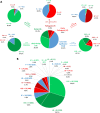Application of next generation sequencing in cardiology: current and future precision medicine implications
- PMID: 37424920
- PMCID: PMC10327645
- DOI: 10.3389/fcvm.2023.1202381
Application of next generation sequencing in cardiology: current and future precision medicine implications
Abstract
Inherited cardiovascular diseases are highly heterogeneous conditions with multiple genetic loci involved. The application of advanced molecular tools, such as Next Generation Sequencing, has facilitated the genetic analysis of these disorders. Accurate analysis and variant identification are required to maximize the quality of the sequencing data. Therefore, the application of NGS for clinical purposes should be limited to laboratories with a high level of technological expertise and resources. In addition, appropriate gene selection and variant interpretation can result in the highest possible diagnostic yield. Implementation of genetics in cardiology is imperative for the accurate diagnosis, prognosis and management of several inherited disorders and could eventually lead to the realization of precision medicine in this field. However, genetic testing should also be accompanied by an appropriate genetic counseling procedure that clarifies the significance of the genetic analysis results for the proband and his family. In this regard, a multidisciplinary collaboration among physicians, geneticists, and bioinformaticians is imperative. In the present review, we address the current state of knowledge regarding genetic analysis strategies employed in the field of cardiogenetics. Variant interpretation and reporting guidelines are explored. Additionally, gene selection procedures are accessed, with a particular emphasis on information concerning gene-disease associations collected from international alliances such as the Gene Curation Coalition (GenCC). In this context, a novel approach to gene categorization is proposed. Moreover, a sub-analysis is conducted on the 1,502,769 variation records with submitted interpretations in the Clinical Variation (ClinVar) database, focusing on cardiology-related genes. Finally, the most recent information on genetic analysis's clinical utility is reviewed.
Keywords: cardiogenetics; cardiovascular diseases; genetic analysis; next generation sequencing; personalized treatment.
© 2023 Papadopoulou, Bouzarelou, Tsaousis, Papathanasiou, Vogiatzi, Vlachopoulos, Miliou, Papachristou, Prappa, Servos, Ritsatos, Seretis, Frogoudaki and Nasioulas.
Conflict of interest statement
EP, DB, GT, AP, GN were employed by Genekor Medical S.A. The remaining authors declare that the research was conducted in the absence of any commercial or financial relationships that could be construed as a potential conflict of interest.
Figures



Similar articles
-
The evolution of comprehensive genetic analysis in neurology: Implications for precision medicine.J Neurol Sci. 2023 Apr 15;447:120609. doi: 10.1016/j.jns.2023.120609. Epub 2023 Mar 5. J Neurol Sci. 2023. PMID: 36905813 Review.
-
Next-Generation sequencing transforming clinical practice and precision medicine.Clin Chim Acta. 2023 Nov 1;551:117568. doi: 10.1016/j.cca.2023.117568. Epub 2023 Oct 13. Clin Chim Acta. 2023. PMID: 37839516 Review.
-
Genomic medicine and risk prediction across the disease spectrum.Crit Rev Clin Lab Sci. 2015;52(3):120-37. doi: 10.3109/10408363.2014.997930. Epub 2015 Jan 19. Crit Rev Clin Lab Sci. 2015. PMID: 25597499 Review.
-
From Somatic Variants Toward Precision Oncology: An Investigation of Reporting Practice for Next-Generation Sequencing-Based Circulating Tumor DNA Analysis.Oncologist. 2020 Mar;25(3):218-228. doi: 10.1634/theoncologist.2019-0239. Epub 2019 Aug 30. Oncologist. 2020. PMID: 32162803 Free PMC article.
-
Somatic cancer variant curation and harmonization through consensus minimum variant level data.Genome Med. 2016 Nov 4;8(1):117. doi: 10.1186/s13073-016-0367-z. Genome Med. 2016. PMID: 27814769 Free PMC article.
Cited by
-
Exploring Health Care Disparities in Genetic Testing and Research for Hereditary Cardiomyopathy: Current State and Future Perspectives.Glob Med Genet. 2024 Feb 1;11(1):36-47. doi: 10.1055/s-0044-1779469. eCollection 2024 Jan. Glob Med Genet. 2024. PMID: 38304308 Free PMC article. Review.
-
MEK inhibitors: a promising targeted therapy for cardiovascular disease.Front Cardiovasc Med. 2024 Jul 1;11:1404253. doi: 10.3389/fcvm.2024.1404253. eCollection 2024. Front Cardiovasc Med. 2024. PMID: 39011492 Free PMC article. Review.
-
Mapping the use of cardiovascular genetic services in pediatric clinical care: challenges and opportunities for improvement.Front Genet. 2025 Jan 7;15:1476466. doi: 10.3389/fgene.2024.1476466. eCollection 2024. Front Genet. 2025. PMID: 39840285 Free PMC article.
-
"Re-evaluation of variants of uncertain significance in patients with hereditary arrhythmogenic disorders".BMC Cardiovasc Disord. 2024 Jul 27;24(1):390. doi: 10.1186/s12872-024-04065-w. BMC Cardiovasc Disord. 2024. PMID: 39068400 Free PMC article.
-
Exploring the Role of Genetic and Genomic Factors in Therapeutic Response to Heart Failure: A Comprehensive Analytical Review.Genes (Basel). 2025 Jul 4;16(7):801. doi: 10.3390/genes16070801. Genes (Basel). 2025. PMID: 40725457 Free PMC article. Review.
References
Publication types
LinkOut - more resources
Full Text Sources

